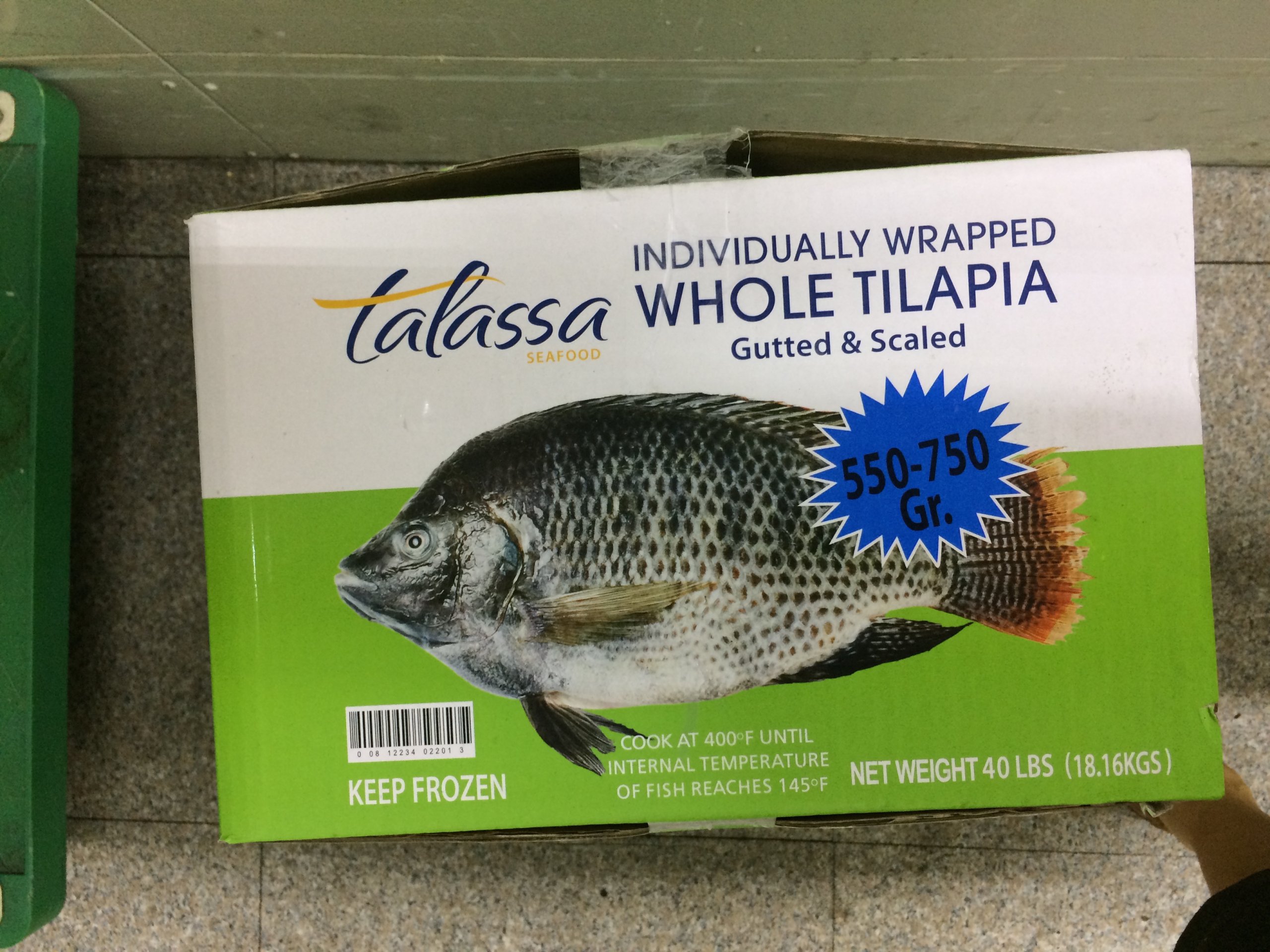Tilapia Market Report: American Samoa, 2019
Introduction
From December 2018 to April 2019, 15 retail grocery stores, one fish market, and nine restaurants in American Samoa were surveyed by Hawai‘i Sea Grant Extension Agent Kelley Anderson Tagarino and American Samoa Community College student interns Raijeli Toanivere, Fuamai A. Tago, and Xu Yi Pan to determine: 1) the origin and volume of frozen tilapia imported by local wholesalers in American Samoa; 2) how often tilapia was purchased by local retailers and restaurants; 3) the size of a typical order; and 4) the imported price, the wholesale price, and the retail price of the frozen tilapia sold in American Samoa. This survey followed the same structure as the 2004 tilapia market survey conducted in American Samoa in order to update changes over the past 15 years.
Import Volume
All of the retail grocery stores (n=15) surveyed are supplied directly or indirectly by frozen imported tilapia from of the Peoples’ Republic of China. The top two off island distributors were Food Links and AJC, which are based in the USA but source tilapia from China. Tilapia were imported in forty-pound cases, the two most common case brands were Talassa and Sunnyvale Seafood. All of the restaurants (n=2) surveyed that serve tilapia obtained their tilapia from local wholesalers.
Altogether, the local wholesale sellers (n=3) surveyed sell a total of 225,600 pounds of tilapia annually, an increase of 58,6000 pounds per year since 2004. Since all local retail stores purchase their tilapia from local wholesalers, this number represents a fair estimate of the total amount of imported tilapia consumed in American Samoa annually.
Purchasing Patterns
Wholesalers receive a shipment of frozen tilapia once a month on average. Most of the retail stores buy their frozen tilapia on an as needed basis that varied from weekly to monthly. Consumption of tilapia is fairly consistent year around, although demand increases during the Catholic Lent period (typically late Feb. to early April). Demand also varies with price fluctuations in both tilapia prices and relevant protein substitutes.
The range in the size of weekly to monthly orders for retail grocery stores ranged from 1-23 cases (40 pounds/case). Most retail-only stores (six out of eight) could not provide the amount of their monthly orders.
Restaurants purchased frozen tilapia on an “as needed” basis. One restaurant with two storefronts on island used ten cases per month between the two locations. The only other restaurant surveyed that has tilapia (as fish and chips) on the menu wasn’t able to provide the amount of orders.

Prices
Frozen tilapia arrives in American Samoa in 40 pound cases of whole fish. Four vendors offer frozen tilapia fillets, but the volume is unknown (likely less than two percent of all tilapia sold). The three local wholesale sellers charge a wholesale price for a case of frozen tilapia of $63.50, $65, and $74 with an average price per case of almost $67.50 per case or $1.69 per pound. This is an increase of $0.69 per pound from the 2004 tilapia market survey average price. Note that one local wholesale/retail combination store said they adjust their local wholesale prices based on supply and demand; for example, when there is a lag in new container shipments they will increase the price for a case of tilapia.
The $1.69 per pound wholesale price is significant because this is the price that the retail stores (other than wholesale/retail combination stores) in American Samoa are paying for frozen tilapia. The retail price for frozen tilapia ranged from $1.61-2.14 per pound, with one remote store on Tutuila charging $3.54 per pound (the $3.54/pound price outlier was removed from the average price/pound calculation).
Number of Vendors / Retail Price Range (dollars/pound)
2 $1.61/lb. – $1.70/lb.
1 $1.71/lb. – $1.80/lb.
3 $1.81/lb. – $1.90/lb.
2 $1.91/lb. – $2.00/lb.
1 $2.14/lb.
1 $3.54/lb.
The average retail price for frozen tilapia is $2.99 per whole fish, or about $1.86 per pound. This is an average mark-up of almost 10% per pound. At $1.86 per pound frozen tilapia is slightly more expensive than the average price per pound of chicken, the lowest non-fish protein substitute available in American Samoa:
2019 retail survey prices per pound / 2004 retail survey prices per pound / Price differential
Chicken $1.69 Chicken $ 0.60 + $1.09
Tilapia $1.86 Tilapia $1.38 + $0.48
Pork $2.30 Pork $1.49 + $0.81
Fresh reef fish $ 3.99 Fresh reef fish $2.61 + $1.38
Beef $ 4.55 Beef $1.63 + $2.92
Frozen pompano $ 4.45 Frozen pompano Unknown Unknown
The two restaurants selling tilapia sell it as: 1) fried in soy sauce as part of a $5 plate lunch (whole or half fish), and 2) as fish and chips for $13.

It would now appear that local tilapia farmers can compete on price with the frozen tilapia that is currently being bought by retailers for $1.69 per pound and sold to consumers in American Samoa for $1.86 per pound. One major change since 2004 is the availability of locally-made, high quality complete tilapia feed through the American Samoa Community College’s Land Grant Aquaculture Program. This program is a partnership with Hawai‘i Sea Grant and provides the machinery, training, and majority of ingredients to farmers free of charge; farmers only need to provide starch source (either local produce like bananas, breadfruit, or taro or store bought wheat flour) and soybean oil. Through this program, the cost to farmers to make fifty pounds of complete feed for tilapia is only $12.69 using wheat flour (flour = $11.16, soybean oil = $1.53), and less if they have access to locally grown starch sources. Furthermore in September of 2019 one local wholesaler/retail store stocked locally grown, fresh whole tilapia and sold it retail for $3.50/pound (the same price as local reef fish), and they sold out quickly. In addition, one local tilapia farmer sells fish directly to consumers for $2.50-3.00 per pound and harvests the live, whole fish by scooping it out of the pond.
The planned next step to directly test the current tilapia market in American Samoa is to provide locally grown, fresh whole tilapia to select stores. Sales records will be collected and added to the updated version of this market report at the end of 2020. Stores that want to continue selling local tilapia will be matched up with local fish farmers so that these vendors can purchase fish directly from the farmers.
Conclusion
Demand has continued to increase for tilapia over the past 15 years in American Samoa despite price increases. With the price increases of frozen imported tilapia and the availability of producing a low-cost, high-quality local feed locally, the fresh tilapia market seems well poised to compete with frozen imported tilapia. While unlikely to be sold cheaper than frozen imported tilapia, there are indications that demand has increased for local fresh tilapia. Direct test marketing through the aforementioned fresh tilapia sales project will provide a definitive answer on the market for locally farmed tilapia in American Samoa.


